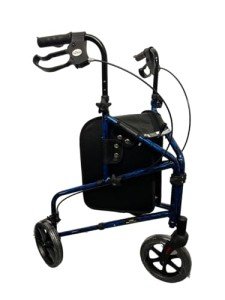Are You Tired Of Rollator Walker? 10 Sources Of Inspiration That'll In…
페이지 정보
작성자 Marisol McIntos… 댓글 0건 조회 5회 작성일 25-06-26 18:27본문

Rollator Walker Safety: A Comprehensive Guide
As people age or face mobility difficulties due to illness or injury, keeping self-reliance frequently ends up being a concern. Rollator walkers, providing both assistance and mobility, have ended up being indispensable tools for numerous. Nevertheless, while they offer many benefits, ensuring safety while utilizing a rollator walker is critical. This article supplies detailed insights into rollator walker safety, including best practices, common hazards, and vital suggestions for users and caretakers.
Understanding Rollators
A rollator walker is a mobility device with wheels that permits individuals to walk with the support of a frame. Unlike standard walkers, rollators usually include:
- Three or four wheels for easier maneuverability
- Hand brakes for stopping and controlling speed
- A seat for resting when required
- Storage compartments for bring individual items
These functions make rollators suitable for both indoor and outdoor use, enhancing the quality of life for users by providing a sense of independence.
Benefits of Using Rollator Walkers
- Increased Mobility: Rollators can assist users in moving around securely and comfortably.
- Support and Stability: With a sturdy frame and brakes, they supply necessary assistance when standing or walking.
- Convenience: Many rollators come with padded seats, allowing users to rest as needed.
- Convenience: Integrated storage solutions can carry necessary products, releasing hands for much better balance.
Typical Hazards Associated with Rollator Walkers
While rollators can enhance mobility and safety, they can also present threats. Users should understand possible threats to decrease accidents:
- Uneven Surfaces: Rollators may tip over if utilized on uneven or sloped surface.
- Braking Issues: Failing to engage the brakes properly can cause falls.
- Excess Weight: Overloading the storage compartments can affect stability.
- Improper Use: Not utilizing the rollator as meant can lead to mishaps.
- Poor Maintenance: Neglecting regular look at wheels and brakes could result in failure throughout use.
Rollator Walker Safety Tips
To improve safety while utilizing rollator walkers, consider the following ideas:
1. Correct Fit and Adjustment
- Height Adjustment: Ensure that the manage height is set to the user's wrist level when standing upright. An appropriate fit encourages much better posture and control.
- Seat Height: If the rollator has a seat, guarantee it's comfy and available for resting.
2. Regular Maintenance
- Examine Brakes: Make sure hand brakes are operating correctly. Adjust or replace them if needed.
- Inspect Wheels: Regularly inspect wheels for wear and tear, and ensure they spin easily.
- Take a look at Frame: Check for loose screws or cracks in the frame to guarantee it stays sturdy.
| Maintenance Task | Frequency |
|---|---|
| Brake inspect | Weekly |
| Wheel examination | Monthly |
| Frame examination | Regular monthly |
3. Environment Awareness
- Clear Pathways: Keep living spaces complimentary from clutter and obstacles that might posture a tripping threat.
- Lighting: Ensure that areas are well-lit to prevent bad moves, particularly during night hours.
- Prevent Slippery Floors: Be careful on wet or waxed floors, as they can lead to falls.
4. Safe Walking Techniques
- Engage Brakes When Stopping: Always engage brakes before sitting or while resting.
- Use Proper Walking Technique: Move slowly and preserve a stable speed, taking actions that match the rollator's width.
- Balance While Turning: Turn carefully, utilizing the rollator for assistance as required.
5. Seek Assistance
- Involve Caregivers: Encourage household members or caretakers to assist in navigating challenging surfaces or scenarios.
- Benefit From Community Resources: Many communities provide mobility training for those using walk-assisting gadgets.
FAQs about Rollator Walker Safety
Q1: How do I select the ideal rollator walker?
When picking a rollator, consider the user's weight, height, and intended use. It's also vital to look for features such as hand brake efficiency and wheel size, which can impact maneuverability.
Q2: Can I use a rollator walker on uneven surface areas?
While rollators can handle a range of surfaces, it is best to avoid steep slopes, gravel, or cobblestones, as these can be unsafe. Stay with flat, smooth surfaces whenever possible.
Q3: How can I avoid falls while utilizing a rollator?
Engaging the brakes when sitting, keeping pathways clear, adjusting your rollator for the proper height, and bearing in mind your surroundings can greatly reduce the threat of falls.
Q4: Are all rollator walkers the same?
No, rollators can be found in different types and sizes, developed for different needs. Some may have additional devices like baskets, while others are lightweight or function a greater weight capability.
Q5: Is it safe to carry bags on a rollator?
Always bear in mind the weight limitation and circulation of the load. Use the rollator's designated storage solutions and avoid straining it.
Rollator walkers are important gadgets that boost mobility and promote self-reliance for users facing mobility difficulties. However, ensuring safety while utilizing these devices is crucial. By comprehending possible threats, adhering to safe practices, and maintaining the walker routinely, users can take pleasure in the benefits of their rollator with reduced threat. Eventually, the objective is to assist in self-confidence and stability, allowing individuals to browse their world with security and ease. As care suppliers, household members, and neighborhoods prioritize safety, they empower users towards a much better, more independent quality of life.

댓글목록
등록된 댓글이 없습니다.